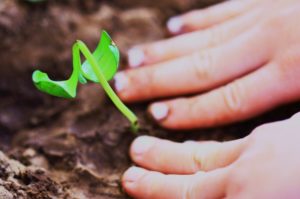There is a Time for Everything, and a Season for Every Activity Under Heaven. Ecclesiastes 3:1
In the first post in this series on planning your garden, we named the 5 P’s of gardening:
Planning
Planting
Perspiring
Picking, and
Putting to bed.
So what time is it now? It is time to plant your garden!
Pointing Forward
What I love about planting is that planting seeds is really a metaphor of our lives as Children of God. As Children of God, we have the opportunity to plant seeds of love and hope in those around us. In many cases we have no idea how that planted seed will develop. Here is a link to an uplifting song about planting seeds: https://www.youtube.com/watch?v=5AmqYcWjBmc.
You may select to plant your garden at your home, or perhaps you are considering a community garden. If a community garden doesn’t currently exist, or it exists but it is too far away, you might consider starting your own. Take a look at ELCA World Hunger’s Community Gardens How-To Guide to get started: http://download.elca.org/ELCA%20Resource%20Repository/WH_GardeningResource.pdf. This resource provides guidance on how to go about pulling together the resources for the community to use.
As stated in this resource, gardening is a beautiful expression of God’s diversity because gardens come in all sorts of sizes, shapes, and scales, from urban plots to rural fields. In almost any circumstance, a person may be able to have a garden because of the diversity of gardens.
The last few years, we have opted to plant our tomatoes in pots on our patio. We did this for several reasons, but largely to make the process more contained and easier to manage. We could see the status of the plants more easily than previously because the tomatoes were right outside our back door, where we go in and out many times a day. Checking the tomatoes became part of going into and out of the house. Pots could even be part of an indoor garden, if you so choose. Personally, I love the appearance and aromas associated with new growth of plants so an indoor garden plot is certainly something to consider, especially if you have limited space outdoors.
Once you’ve decided where to plant, some preparation is required. You want to give the fetal plants the best chance of surviving and flourishing so that you can harvest a great abundance later in the Summer or Fall.
Planting a garden reminds me of Mark 4:3-8, where the farmer scatters seed in four different locations. First, he scattered the seed along the path, then in rocky places, and then among the thorns. Of course, none of these seeds produced much of anything because the place of the planting did not support the growth of the plant.
Finally, the farmer got it right and sowed the seeds on good soil. And that is what we want to do. How do we ensure that the soil is good and will support growth and development of the plants?
There are several options to enrich the soil with nutrients to enhance plant growth. Composting is a great way of using your own yard and kitchen wastes to develop your soil. There are many good websites to use for composting instructions. Try Composting Junkie at http://www.compostjunkie.com/how-to-compost.html.
Composting is about taking the nutrients that are found in yard waste—such as leaves—and kitchen waste—such as onion skins, potato skins, and other vegetable wastes—and ‘digesting’ these wastes using billions of microorganisms (bacteria and fungi) found in the soils. The structure of the leaves is broken down by the microorganisms into smaller substances that the germinating seeds and sprouts can use for nourishment and growth.
Composting can be done simply by mixing the wastes with soil and adding water in bins or in piles. Many people use rotating bins so that the mixture of wastes can be rotated to increase the rate of breakdown of the waste products.
Once the waste has degraded to a rich, soil-like consistency, it may be added to your growing area as a type of natural fertilizer.
Linking Back
In the last post, we used some of the crops we had stored over the winter to make a mashed potato soup, using potatoes, onions and some garlic and herbs.
In today’s recipe, we will still rely on last year’s root crops while adding some diversity to the offerings. Roasted Root Vegetables are a favorite of our family and can be prepared at any time of the year. Because the bulk of the recipe ingredients come from root vegetables, these may come from last year’s crop that you have stored in cool, dry places over the winter.
It is also easy to add variety to this recipe because you can throw in almost any of your favorite veggies to mix it up a bit. In the recipe below, we use all root vegetables, yet you could add squash or brussel sprouts or any other substantial vegetable for color, flavor and variety.
Until next time, remember,
There is a Time for Everything, and a Season for Every Activity Under Heaven. Ecclesiastes 3:1
Roasted Root Vegetables with Maple Glaze
This dish is vegan and gluten-free and originally appeared in Cooking Light.
Ingredients
1 1/2 cups (1/2-inch) slices carrot
1 1/2 cups (1/2-inch) slices parsnip
1 1/2 cups (1/2-inch) cubed peeled turnip
4 teaspoons olive oil
1/2 teaspoon kosher salt
1/4 teaspoon freshly ground black pepper
Cooking spray
2 tablespoons maple syrup
Preparation
- Preheat oven to 450°.
- Combine first 6 ingredients in a 13 x 9–inch baking dish coated with cooking spray, tossing well to coat. Bake at 450° for 10 minutes. Stir in syrup. Bake an additional 20 minutes or until tender and golden, stirring after 10 minutes.
Yield:
4 servings (1/2 cup)
Nutritional information (per serving)
Calories 150 (30% from fat)
Fat 4.9 g
Saturated fat 0.7 g
Monounsaturated fat 3.3 g
Polyunsaturated fat 0.6 g
Protein 1.7 g
Carbohydrate 26.1 g
Fiber 3.8 g
Cholesterol 0.0 mg
Iron 0.8 mg
Sodium 379 mg
Calcium 63 mg
 In this series by guest writer Ethan Bergman, we will consider the 5 P’s of gardening – planning, planting, perspiring, picking, and putting to bed – over the course of the next few months. Ethan is a Master of Divinity student in the Distributive Learning program at Luther Seminary, St. Paul, Minn. Bergman is also the associate dean in the College of Education and Professional Studies and professor of food science and nutrition at Central Washington University, Ellensburg. He was named CWU Distinguished University Professor in 2001-2002 and was named by the Washington State Dietetic Association as Outstanding Registered Dietitian of the Year in 2000. He is a past delegate and past President of the American Dietetic Association as well as speaker of the Academy’s House of Delegates. He has served on the Academy’s Educator’s Task Force on Education Reform in Dietetics Education and on the Evidence-Based Practice Committee. Bergman earned his doctorate from Washington State University.
In this series by guest writer Ethan Bergman, we will consider the 5 P’s of gardening – planning, planting, perspiring, picking, and putting to bed – over the course of the next few months. Ethan is a Master of Divinity student in the Distributive Learning program at Luther Seminary, St. Paul, Minn. Bergman is also the associate dean in the College of Education and Professional Studies and professor of food science and nutrition at Central Washington University, Ellensburg. He was named CWU Distinguished University Professor in 2001-2002 and was named by the Washington State Dietetic Association as Outstanding Registered Dietitian of the Year in 2000. He is a past delegate and past President of the American Dietetic Association as well as speaker of the Academy’s House of Delegates. He has served on the Academy’s Educator’s Task Force on Education Reform in Dietetics Education and on the Evidence-Based Practice Committee. Bergman earned his doctorate from Washington State University.


